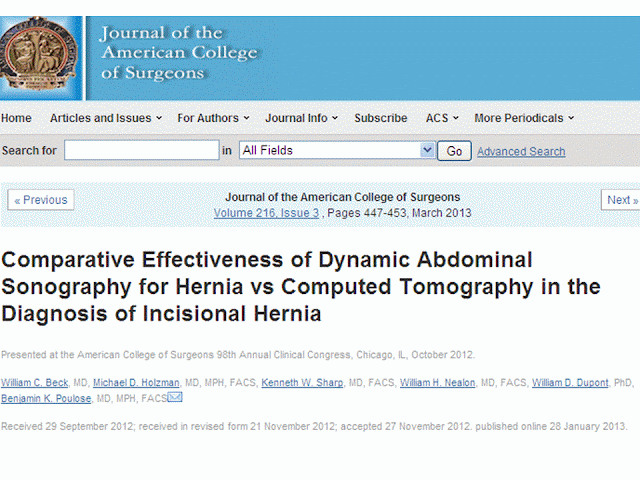Asymptomatic lung congestion has been shown to increase dialysis
patients’ risks of dying prematurely or experiencing myocardial infarctions or
other cardiac events, according to recent research.
The findings also revealed that utilizing lung ultrasound to
identify this congestion aids in diagnosing patients at risk. Italian
investigators recently measured the degree of lung congestion in 392
dialysis patients by using a very simple and inexpensive technique –
lung ultrasound.
Lung congestion due to fluid accumulation is very common
among kidney failure patients on dialysis, but it frequently does not cause any
symptoms. To see whether such asymptomatic congestion affects dialysis patients’
health, Carmine Zoccali, MD, from Ospedali Riuniti (Reggio Calabria, Italy; www.rc.ibim.cnr.it) and his colleagues published
their study findings February 28, 2013, in the
Journal of the American Society of Nephrology (JASN).
Among the major findings (1) Lung ultrasound revealed very
severe congestion in 14% of patients and moderate-to-severe lung
congestion in 45% of patients. (2) Among those with moderate-to-severe
lung congestion, 71% were asymptomatic. (3) Compared with those having slight
or no congestion, those with very severe congestion had a 4.2-fold increased risk
of dying and a 3.2-fold increased risk of experiencing heart attacks or other
cardiac events over a two-year follow-up period. (4) Lastly, asymptomatic lung congestion
identified by lung ultrasound was a better predictor of patients’ risk of dying
prematurely or experiencing cardiac events than symptoms of heart failure.
By evaluating subclinical pulmonary edema can help better
establish dialysis patients’ prognoses, according to the findings.The researchers will soon initiate a clinical trial that
will integrate lung fluid measurements by ultrasound and will examine whether
dialysis intensification in patients with asymptomatic lung
congestion can reduce the risk of heart failure and cardiac events and prevent
premature death.
From MII, June 2013
Background
Advancement in dialysis technology and new drug therapies of
uremic complications are major achievements of modern nephrology. As a result
of progress in the care of ESRD, a continuous increase in survival of dialysis 4
patients has been documented over the last 13 years in the European Renal
Association-European Dialysis Transplant Association (ERA-EDTA) registry (1). Adequate
control of fluid balance is a primary goal of dialysis treatment and experience
in centres applying strict volume control policies documented a remarkable reduction
in mortality in comparison with average mortality rate in well matched cohorts
in the USRDS and in the ERA-EDTA Registry (2). Even though specific
recommendations in past and current guidelines emphasise the risk of volume
overload, the problem still remains pervasive in the dialysis population (3).
Unsatisfactory control of volume expansion depends on various reasons
encompassing both medical and non-medical factors such as reimbursement of the cost of extra or longer
dialyses and other organizational and logistic factors. As to the medical
factors, it is widely agreed that the high prevalence of patients with LV
dysfunction and heart failure and the lack of simple, non-expensive, bedside
techniques that may serve to estimate and monitor parameters of central
hemodynamics for guiding the prescription of ultrafiltration (UF) and drug
treatment is a factor of major clinical
relevance.
Extra-vascular lung water (LW), a fundamental component of
body fluids volume, represents the water content of the lung interstitium which
is strictly dependent on the filling pressure of the left ventricle (4; 5).
Chest ultrasound (US) has recently emerged as a reliable technique for
detecting LW in intensive care patients (6) and in patients with heart failure
(7). The basic principle of this technique is that in the presence of excessive
LW, the ultrasound beam is efflected by subpleural thickened interlobular
septa, a low impedance structure surrounded by air with a high acoustic mismatch. US
reflection generates hyperechoic reverberation artefacts between thickened
septa and the overlying pleura which are defined “lung comets” (8). These
artefacts are easily detected with standard US probes and chest US has been formally
validated as a reliable technique to estimate LW in patients with heart diseases (9). This method
captures changes in LW which occur across dialysis and the feasibility and
repeatability of chest US studies in hemodialysis patients has been recently described
(10). However the clinical usefulness of this technique in the everyday care in
ESRD patients is still untested and it remains unknown whether systematic
application of chest US may translate into better clinical outcomes in these
patients. With this background in mind the European Renal and Cardiovascular
Medicine (EURECA-m) working group of the ERA-EDTA designed a
randomised, multicenter, clinical trial investigating whether a treatment
policy based on LW monitoring in haemodialysis patients by chest US is more
effective than standard clinical monitoring for reducing death, decompensated
heart failure and myocardial infarction and prevent the evolution of LVH and LV
dysfunction in patients with myocardial ischemia or heart failure over a 2-year
follow-up.
This trial will be the first which formally tests a
biomarker as a guide the optimize volume control and drug treatment in high
risk dialysis patients. Other promising indicators of fluid volume in dialysis
patients - such as body impedance analysis (BIA) or cardiac natriuretic
peptides - have never been tested into a clinical trial, which is a basic
requirement for recommending systematic use of biomarkers in clinical practice.






